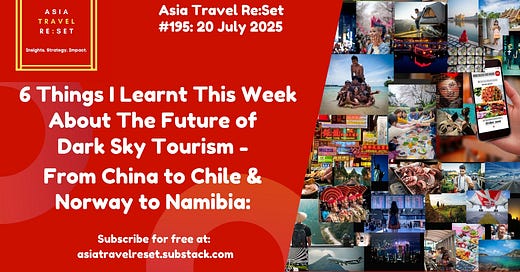Issue #195: 6 Things I Learnt This Week About the Future of Dark Sky Tourism
From China to Chile, Norway to Namibia, the US to New Zealand... and beyond.
Welcome to Issue 195 of Asia Travel Re:Set.
Almost 30 years ago, I was stood by a roadside in rural Ecuador.
It was 3.55am, and I’d been promised that at 4am one of only 2 daily buses would transport me - and a full load of locals taking their produce to market - to Latacunga.
By day, the Andean landscapes were majestic - but in the blackness of night, they became truly hypnotic.
I had never seen so many stars in my life - and in an entirely cloudless sky.
I still carry that scene with me.
This week, I got to speak with a genuine expert, Megan Eaves, about a fast-growing niche segment founded on the planet’s natural rhythms: Dark Sky Tourism.
Thanks for checking in…
6 Things I Learnt About the Future of Dark Sky Tourism
The great pleasure of hosting 2 travel podcasts is speaking to knowledgeable experts that really know their stuff - and are generous with their insights and analysis.
This week, I chatted with Megan Eaves, a global authority on dark sky tourism. Megan is a delegate for DarkSky International, editor of Nightscape magazine, and author of the forthcoming book, Nightfaring: In Search of the Disappearing Darkness - the research for which took her from New Zealand to Uzbekistan, and Argentina to Japan. Her upcoming night tourism trips include Norway and Namibia.
Here’s a selected summary, but we packed so much into the podcast, that I’d highly recommend listening to the full discussion / reading the transcript.
1) What’s in a Name?
“Humans have been looking at the stars, and recording astronomical events like comets and meteor showers onto rock carvings, for tens of thousands of years.” Tourism founded on nocturnal skies has gained new traction over the past decade. Various terms - Stargazing, Astro Tourism, Dark Sky Tourism - get used interchangeably. Dark sky advocates, scientists, indigenous leaders and the travel industry are yet to settle on a name that encompasses diverse activities, like watching starry skies, super and blood moons, eclipses and Aurora Borealis & Aurora Australis.
2) Sky Watching Across Continents
“A problem for tourism boards is that many places don’t have dark skies. London can’t promote it.” Across continents, nations and regions with natural assets unpolluted by artificial light are promoting dark sky experiences, like Ningxia in China, Utah in the US, a starlight reserve in Spain’s Canary Islands, and New Zealand’s Dark Sky Project. Other case studies we discussed include Africa’s first dark sky reserve (Namibia), an astronomy tourism centre in Chile, and La Ruta de las Estrellas in Argentina.
3) Dark Sky Accreditations
How do dark sky parks and reserves get accredited? I’ve often wondered this, and Megan put me straight. DarkSky International undertakes a complex “UNESCO-type process” to certify parks dedicated to nocturnal tourism that take a series of steps to conserve starry-skied natural spaces. Recently, it launched a lodging accreditation for accommodations that provide “exceptional quality starry nights.”
4) Protecting the Night
“One way of thinking about it is not just as stargazing tourists, but as the idea of nocturnal conservation. We are seeing across the industry this wonderful marriage of low-impact, mindful tourism to places that are doing strong nature conservation work. Those are, I think, the travellers who support dark skies. They may not really care which is Mars or Venus, but they may care that bad outdoor lighting impacts migratory birds.”
5) What is ‘Starwashing’?
“It’s a form of greenwashing. Dark sky tourism is very visual. You can take incredibly beautiful photos with a camera that your eyes cannot see. So what you see on a marketing brochure may not be what you see with your eyes when you get to a destination. There is a risk of a property or a tour company marketing stargazing without taking on the responsibility they have to go about protecting that eco-system.”
6) Dark Sky Tourism is Making News
Although still a nascent niche, dark sky tourism is reaching mainstream audiences. In 2024, Condé Nast Traveler made Astro Tourism its No 1 trend to watch. Booking.com selected Noctourism as its top prediction for 2025.
This week saw publication of the annual review of responsible International Dark Sky Places. Plus, New Scientist launched tours for “the most impressive total solar eclipses of our lifetimes [which] will be visible from Spain, Egypt, and Australia over the next three years.”
⏩ Click on the live link below to listen to Exploring the Future of Stargazing & Dark Sky Tourism, with Megan Eaves, Nightfaring
Or search for High-Yield Tourism on any podcast app.
What’s Next for Low-Cost Carrier Travel in ASEAN & APAC?
South East Asia’s LCC skyscape is evolving. To assess the shifting outlook for budget air travel in ASEAN and beyond, I’m joined on this week’s The South East Asia Travel Show, by Shantanu Gangakhedkar, KL-based Senior Consultant, Aerospace & Defense, at Frost & Sullivan. Issues we discuss include:
✈️ Why ASEAN-based LCCs are adding longer-range aircraft to their fleets and expanding their geographic reach for passengers.
✈️ Fare pricing, fierce market competition and AI advances in air traffic management.
✈️ Testing the potential of South East Asia's tier-2 and tier-3 cities.
✈️ The exit of Jetstar Asia from Singapore.
✈️ And, the elephant in the departures lounge: the current and potential supply chain impacts for the airline industry of (changeable) US tariffs.
⏩ Click on the live link below to listen to South East Asia’s New Low-Cost Carrier Landscape: What’s Next for Budget Air Travel?
Or search for The South East Asia Travel Show on any podcast app.
And, that’s a wrap for Issue 195.
Asia Travel Re:Set will return next Sunday. Meantime, find me on LinkedIn.
Happy travels,
Gary






